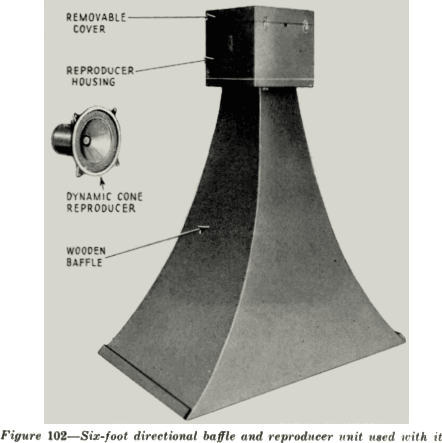These speakers are mounted in a rack directly behind the screen and as close to it as is possible without
actually touching it. All parts of the rack surrounding the reproducer unit and the baffle itself are
covered with sound absorbing material. This material is also used to cover the back of the screen,
except where the speaker openings are located. This effectively deadens all sound which might escape
back stage, reflect off hard walls and thus through the proscenium opening to the auditorium. This
makes sure that the only outlet for the sound is through the portions of the porous screen adjacent to
the mouths of the speakers.

Figure 103 shows the housing on the baffle in which the reproducer unit is mounted. The end of this
box is removable to give access for servicing. A filter unit is placed here, and is connected across the
voice coil. Its purpose is to eliminate
undesirable frequencies introduced by needle scratch, etc. The Type PL-22 loudspeaker, used with the
PG-13 equipments, is illustrated.
154. Location.- Anywhere from one to four speakers may be used in a theatre, and in some cases, more.
The number and arrangement to be used in each particular case is worked out beforehand from the
plans of the theatre in order to obtain the best distribution of sound. The speaker unit itself has an
effective sound distribution over an area 30 degrees on each side of the speaker axis horizontally, and
15 degrees each side of the axis vertically. When one speaker is used it should be placed at the center,
or slightly above the center, of the screen and close to it, as mentioned before. The location of the
loudspeakers directly behind the screen
gives the best illusion; that is, the apparent effect of speech is such that the actors in the picture
actually seem to be speaking from the stage.
7
